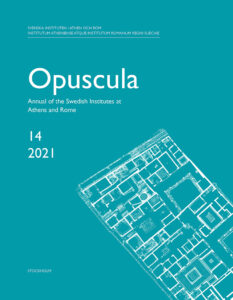 Opuscula 14 is published with open access. Printed edition distributed by Eddy.se AB. Also available at Amazon.com, Adlibris, and Bokus. View volume at ERIH PLUS.
Opuscula 14 is published with open access. Printed edition distributed by Eddy.se AB. Also available at Amazon.com, Adlibris, and Bokus. View volume at ERIH PLUS.
From 2D and 3D documentation to 4D interpretation. Building archaeological conclusions and workflow strategies gained by remote study of Insula V 1, Pompeii
By Anne-Marie Leander Touati (Lund University, Sweden), Thomas Staub (Lund University, Sweden) & Renée Forsell (Lund University, Sweden)
Abstract
The text describes new methods elaborated for and used in the building archaeological assessment of a city block, studied first on site, then remotely by members of the Swedish Pompeii Project. Use of a digital platform, with collected wall observations and analysis, systematic photographic documentation of all standing structures, and 3D models, allowed discussion to proceed after the fieldwork came to an end. The models provided new possibilities and new angles of approach, e.g. examining walls at any given point, studying boundary walls as wall-strings in their full extent, allowing all kinds of sectioning at will, introducing bird’s-eye views as a new perspective in study, and measuring wherever needed. The joint results obtained are summed up in a four-phase development of the use of space: the earliest structures; the late Samnite building boom (2nd century BC); the colony (second half of 1st century BC); the imperial era (until AD 79). This narrative includes conclusions concerning building process and development of masonry techniques and on changes in way of life. Many results affect Pompeian archaeology in general. Results of particular importance concern the character of the early plot division and the understanding of the building process creating the double-atrium house of Caecilius Iucundus, including an anchorage in time for this creation in the Claudian period. The relatively small impact in terms of damage that may be ascribed the literary recorded earthquake of AD 62/63 is also worth noting. The text ends with a suggestion of a new workflow for insula studies.
Download PDF - Size: 2.44 MB - Downloads: 159 (since 2023)
Bibliographical information
Anne-Marie Leander Touati, Thomas Staub & Renée Forsell, ’From 2D and 3D documentation to 4D interpretation. Building archaeological conclusions and workflow strategies gained by remote study of Insula V 1, Pompeii’, Opuscula. Annual of the Swedish Institutes at Athens and Rome (OpAthRom) 14, Stockholm 2021, 181-226. ISSN: 2000-0898. ISBN: 978-91-977799-3-7. Softcover, 478 pages. https://doi.org/10.30549/opathrom-14-11

No Comments
Comments are closed.